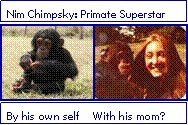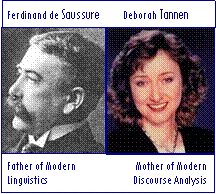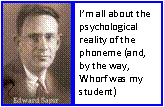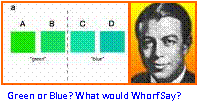Tuesday, February 26, 2008
Ebonics and AAVE
Also be prepared for questions about our class discussions of AAVE and Ebonics from your notes.
Midterm Exam
The test is cumulative, as usual. So there will be stuff from Language Essentials, Design Features, Orthography, Biological Adaptations, Vocal Tract Anatomy, IPA, Consonants and their feature bundles, vowels and their feature bundles, basics about the difference between a phone and a phoneme as well as between phonemes and allophones. Know the allophones of /t/ and /l/ we have covered in particular. There will be an English sentence that you will have to transcribe into IPA. You need to know natural classes and minimal pairs-if I give you ten phones you should be able to say what natural class they belong to (i.e., what feature(s) do they all share? Basics about sound systems of the worlds languages, etc. No phonology problems per se yet because we haven't covered that yet. Basics about syllable structure and rhythm versus syllable timed languages and how that relates to the schwa, etc. Be able to write out the consonant chart and the vowel chart from memory (on scrap paper. So basically from Behemoth II all you need is minimal pairs and natural classes. But you need to know everything from the other chaplets and all classes up to yesterday.
Monday, February 18, 2008
Follow up on AAVE
Today I said that AAVE is going the same direction SAE is going it's just going there faster. I definitely wasn't referring to everything about AAVE. We were talking about one of the most stigmatized features of working class English and AAVE: third person inflection "he does" vs. "he do". English used to have 6 different inflections for each of the different conjugations of, for example do, doest, does, etc. SAE is down to 2: I/You/We/ They do, he/she/it does. AAVE has just gone the next step and eliminated the does, same direction SAE is going.
That's all for now. (:
That's all for now. (:
Thursday, February 14, 2008
The Rich List Part 1

You can always be assured that I won't give you transcriptions that make you choose between dialects for the pronunciation of a particular word. (Not just because I love you, but because I love ME!) (: The questions test your knowledge of what sounds each symbol represents. If there ever is a doubt about whether you really do pronounce a word the way you maintain, all you have to do is pronounce it for me and if you really do produce the sounds you claim, then of course you will get those points.
You can get extra credit by bringing in a video clip of someone pronouncing a word in a particularly marked way, one that differs from the SAE (Standard American Englis) pronunciation.
human biological adaptations mnemonic
mnemonic for brain larnyx lungs lips tongue teeth.
so: because linguists love language they talk. -Elizabeth Wells-
Lisa taught Tim Linguistics by lunch. -Brian Smith-
Two Little Toys Live Like Boys
Teeth Lips Tongue Larynx Lungs Brain -Amelia Butler-
Black Lizards Like To Talk Loosely. -Amanda Netherly-
"you're Too Little To Laugh Little Boy!" -Whitney Swanson et al-
Little (lips) Toto (tongue) Loves (larynx) Lions (lungs), Tigers (teeth), & Bears (brain)! Valerie Brak
mnemonic for places of articulation-consonant ipa chart
Ben Ladin is a pretty vicious guy.
Bilabial- Labiodental-Interdental-Alveolar-Palatal-Velar-Glottal -Ashley Cooper-
Subscribe to:
Posts (Atom)













